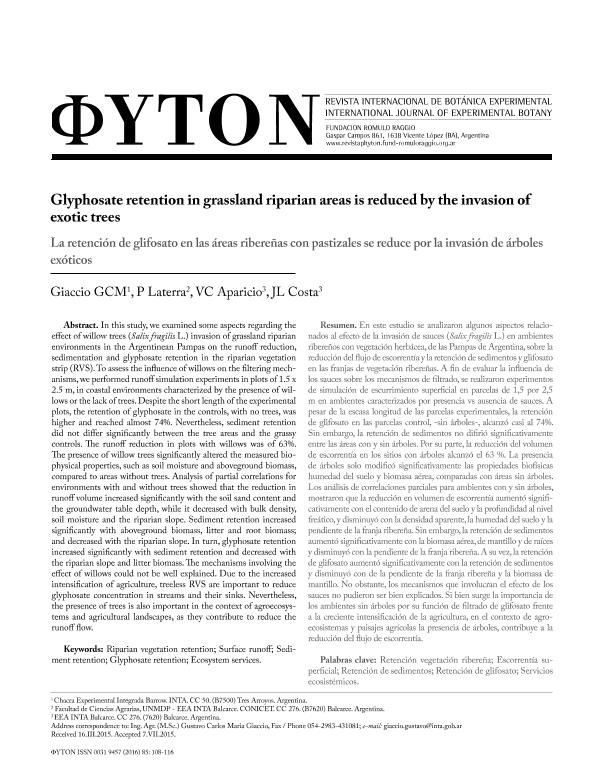Artículo
En este estudio se analizaron algunos aspectos relacionados al efecto de la invasión de sauces (Salix fragilis L.) en ambientes ribereños con vegetación herbácea, de las Pampas de Argentina, sobre la reducción del flujo de escorrentía y la retención de sedimentos y glifosato en las franjas de vegetación ribereñas. A fin de evaluar la influencia de los sauces sobre los mecanismos de filtrado, se realizaron experimentos de simulación de escurrimiento superficial en parcelas de 1,5 por 2,5 m en ambientes caracterizados por presencia vs ausencia de sauces. A pesar de la escasa longitud de las parcelas experimentales, la retención de glifosato en las parcelas control, -sin árboles-, alcanzó casi al 74%. Sin embargo, la retención de sedimentos no difirió significativamente entre las áreas con y sin árboles. Por su parte, la reducción del volumen de escorrentía en los sitios con árboles alcanzó el 63 %. La presencia de árboles solo modificó significativamente las propiedades biofísicas humedad del suelo y biomasa aérea, comparadas con áreas sin árboles. Los análisis de correlaciones parciales para ambientes con y sin árboles, mostraron que la reducción en volumen de escorrentía aumentó significativamente con el contenido de arena del suelo y la profundidad al nivel freático, y disminuyó con la densidad aparente, la humedad del suelo y la pendiente de la franja ribereña. Sin embargo, la retención de sedimentos aumentó significativamente con la biomasa aérea, de mantillo y de raíces y disminuyó con la pendiente de la franja ribereña. A su vez, la retención de glifosato aumentó significativamente con la retención de sedimentos y disminuyó con de la pendiente de la franja ribereña y la biomasa de mantillo. No obstante, los mecanismos que involucran el efecto de los sauces no pudieron ser bien explicados. Si bien surge la importancia de los ambientes sin árboles por su función de filtrado de glifosato frente a la creciente intensificación de la agricultura, en el contexto de agroecosistemas y paisajes agrícolas la presencia de árboles, contribuye a la reducción del flujo de escorrentía. In this study, we examined some aspects regarding the effect of willow trees (Salix fragilis L.) invasion of grassland riparian environments in the Argentinean Pampas on the runoff reduction, sedimentation and glyphosate retention in the riparian vegetation strip (RVS). To assess the influence of willows on the filtering mechanisms, we performed runoff simulation experiments in plots of 1.5 x 2.5 m, in coastal environments characterized by the presence of willows or the lack of trees. Despite the short length of the experimental plots, the retention of glyphosate in the controls, with no trees, was higher and reached almost 74%. Nevertheless, sediment retention did not differ significantly between the tree areas and the grassy controls. The runoff reduction in plots with willows was of 63%. The presence of willow trees significantly altered the measured biophysical properties, such as soil moisture and aboveground biomass, compared to areas without trees. Analysis of partial correlations for environments with and without trees showed that the reduction in runoff volume increased significantly with the soil sand content and the groundwater table depth, while it decreased with bulk density, soil moisture and the riparian slope. Sediment retention increased significantly with aboveground biomass, litter and root biomass; and decreased with the riparian slope. In turn, glyphosate retention increased significantly with sediment retention and decreased with the riparian slope and litter biomass. The mechanisms involving the effect of willows could not be well explained. Due to the increased intensification of agriculture, treeless RVS are important to reduce glyphosate concentration in streams and their sinks. Nevertheless, the presence of trees is also important in the context of agroecosystems and agricultural landscapes, as they contribute to reduce the runoff flow
Glyphosate retention in grassland riparian areas is reduced by the invasion of exotic trees
Título:
La retención de glifosato en las áreas ribereñas con pastizales se reduce por la invasión de árboles exóticos
Fecha de publicación:
06/2016
Editorial:
Fundación Rómulo Raggio
Revista:
Phyton
ISSN:
0031-9457
e-ISSN:
1851-5657
Idioma:
Inglés
Tipo de recurso:
Artículo publicado
Clasificación temática:
Resumen
Archivos asociados
Licencia
Identificadores
Colecciones
Articulos(CCT - PATAGONIA NORTE)
Articulos de CTRO.CIENTIFICO TECNOL.CONICET - PATAGONIA NORTE
Articulos de CTRO.CIENTIFICO TECNOL.CONICET - PATAGONIA NORTE
Citación
Giaccio, Gustavo Carlos María; Laterra, Pedro; Aparicio, Virginia Carolina; Acosta, José Luis; Glyphosate retention in grassland riparian areas is reduced by the invasion of exotic trees; Fundación Rómulo Raggio; Phyton; 85; 6-2016; 108-116
Compartir




